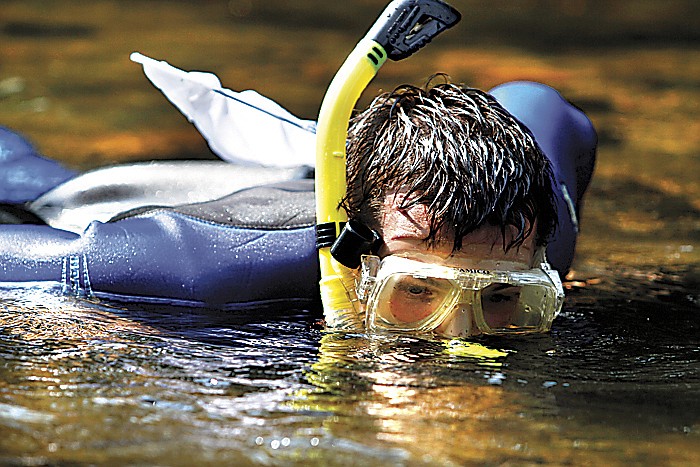Move over, sturgeon.
The Tennessee Aquarium is taking on another rare-fish rescue, similar to the one the aquarium's Conservation Institute has been working for the past decade with the Tennessee River sturgeon.
This time, the focus is on the Conasauga logperch.
"Our best estimate is that only about 200 adult Conasauga logperch are left," said Anna George, director of the Tennessee Aquarium Conservation Institute. "It's federally endangered because it is only found in the Conasauga River. And one 20-mile stretch of river is their entire range in the entire world."
The Conasauga logperch is one of the rarest darters in North America. The 6-inch logperch lives in the area where the pristine Conasauga water flows out of the Cherokee National Forest into Polk County, Tenn., then ripples southward into North Georgia.
The brownish fish with tiger stripes uses its piglike flattish, pointy snout to flip pebbles on the crystal-clear river bottom, then eats the insects it finds beneath.
"They lay their eggs in the sand, so they need a really clear river, which is part of the reason they're still hanging on here in the Conasauga," George said. "It has great water quality and cool clear water coming off these mountains in Georgia and Tennessee."
Last week, she and other researchers snorkeled areas of logperch habitat to find eight of the elusive darters.
In captivity, the eight, combined with three others now belonging to Conservation Fisheries, will become the Adams and Eves of a captive breeding program - much like the one that has brought the Tennessee River sturgeon back from the brink of extinction.
"We're working with Conservation Fisheries, a nonprofit group based in Knoxville, so we can augment the natural population size here in the river as well as keep an ark population," George said. "That way if any environmental catastrophes happen in the Conasauga River, we would have fish in captivity that can be released."
Pat Rakes, a founder and co-director of Conservation Fisheries, said biologists are beginning to get very concerned about the logperch's future.
"Obviously, this is not something you're going to find in slow, muddy rivers," he said. "This is a fish that buries its eggs in sand. It has to have clean sand to lay the eggs, otherwise they're going to get smothered and die from lack of oxygen.
"Like a lot of our darters, they are canaries in the coal mine. They are a good indicator of water quality."
Logperch lessons
Rakes and George said the fish also offers scientists an opportunity to unravel a genetic mystery: How they survive in such a small range and in such small numbers without apparent inbreeding.
"There is far higher genetic diversity than would be expected in that fish, given its small numbers and small range," Rakes said. "Anna's hypothesis is that somehow the fish are recognizing who's closely related with them."
George, who studied the Conasauga logperch for her doctorate in biology, said she wants to know more.
"We think they've adapted some sort of behavior where they seek out other logperch different from them to breed with, and that maximizes genetic diversity," she said.
It also might explain why the Conasauga logperch never has been successfully bred in captivity.
THE STURGEON STORYFor millennia until the 1960s, the three East Tennessee rivers were the nurseries of sturgeon - a fish species so old it saw the rise and fall of dinosaurs.The sturgeon had disappeared from the Tennessee River basin by 1960, until the Tennessee Aquarium began a 25-year reintroduction program in 1998.To date, more than 90,000 sturgeon have been raised and reintroduced to the Tennessee Valley - about 8,000 by the Tennessee Aquarium Conservation Institute.Research has shown some of the fish, which can live to be 100, have traveled at least 550 miles along the 652-mile Tennessee River.Source: Tennessee Aquarium Conservation Institute
The researchers are incorporating genetics research on the fish to unravel the mystery. The research will be done by Tennessee Aquarium personnel using lab space and equipment at the University of Tennessee at Chattanooga.
Aside from the learning the biology of the fish, researchers said their effort is not just to save the Conasauga logperch - it's also about saving the habitat of the last clean section of the Conasauga River.
"This is one of the last rivers we have in the U.S. that has some of these endangered species in it, and these (the logperch) are just an indicator of how important this habitat is," George said.
"If we start losing these species, then we stand more at risk for having water that is not safe for humans to play in or drink from, or any of those things we enjoy rivers for."
Rakes put it a different way.
"When we lose this fish, it means we've crossed a threshold with ... too much human-caused sediment input," he said.
"What does that mean to us? It means the stream is getting too nasty for us to use, means we have to spend a lot of money to be able to use it again.
"And if you want to look at it from the tree-hugger way: This is a system that has taken millions of years to be like it is. What right do we have in a few decades to destroy it?"
Continue reading by following these links to related stories:

